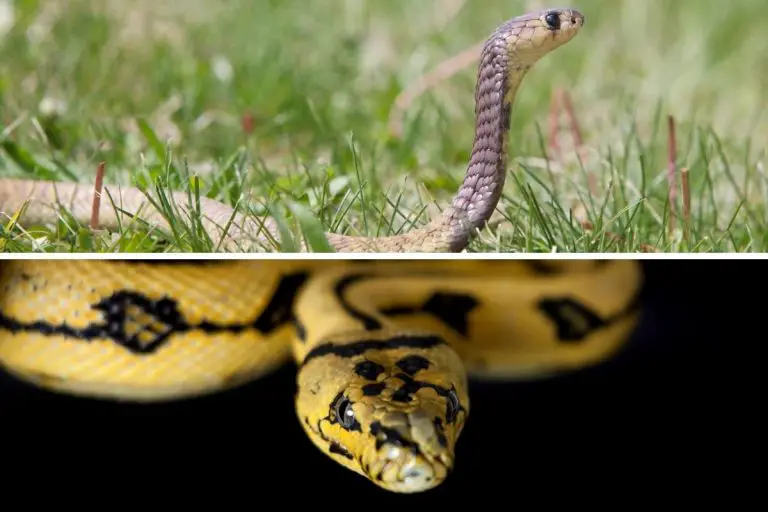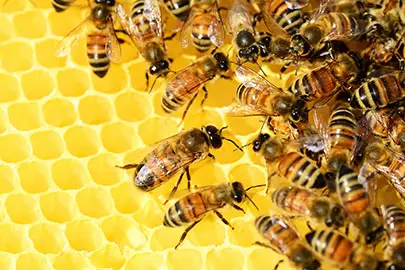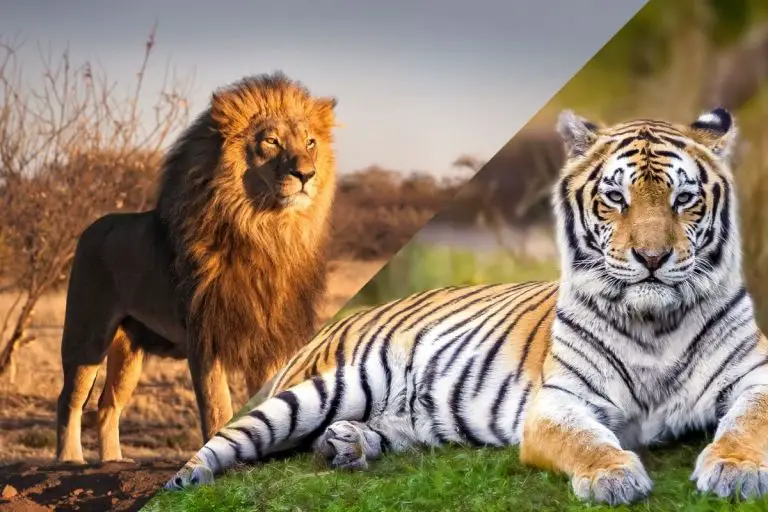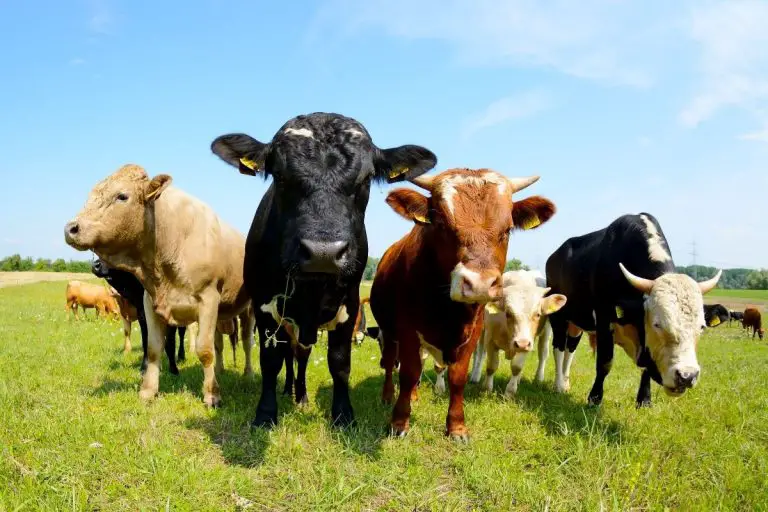What’s the Difference between Pythons and Anacondas?
Pythons and anacondas are among the largest snake species in the world, and both belong to the Class Reptilia.
But do you know their differences? That’s what we’ll see in this article
As a whole, anacondas enjoy aquatic habitats, while pythons prefer land. Anacondas also tend to have a shorter life span than pythons (up to 35 years!), while being heavier than pythons overall.
But both are large families, including many species with various specifications, so it’s hard to compare them directly in a short answer.
Anacondas belong to the boa constrictor family, so they fall into the opposing constrictor category of python species. Boa constrictors and pythons are the only two groups of snakes that are considered to be constrictors, which means they constrict their prey until it is no longer breathing and lifeless.
Pythons
Are Pythons Venomous?
It is common knowledge that snakes can be either venomous or non-venomous.
Venomous snakes can produce a deathly venom that is conveyed to their prey by large fangs that pump the venom into their food.
Non-venomous snakes have different methods of killing their prey.
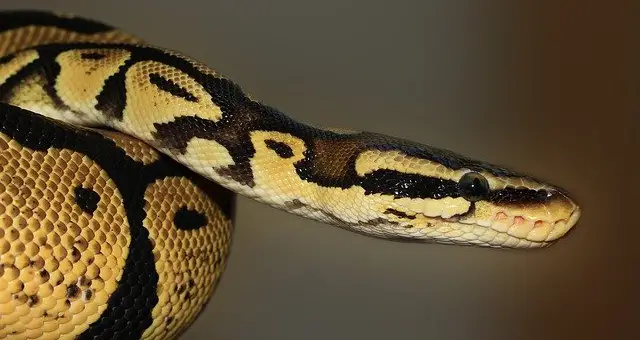
Pythons are non-venomous constrictors, which means they wrap their ginormous bodies after they ambush their prey and squeeze it until it can no longer breathe and dies.
Pythons never chase a meal choosing to ambush and overpower their prey. To eat larger animals, pythons unhinge their jaws, so they can swallow their food whole!
Python Species
Pythons have over 30 known species. The Reticulated Python, Burmese Python, Pygmy Python, and African Rock Python species are better known.
Python species range from the world’s heaviest python recorded, the Reticulated Python, to the world’s smallest, the Pygmy Python.
Naturally carnivorous, the Pygmy Python is a rust color which comes in handy when they attempt to camouflage themselves in Australia’s outback. The Pygmy Python feeds on small skinks, lizards, geckos, and small mammal species.
While many snake species enjoy swimming, the Reticulated Python have been known to swim from island to island even though this species is one of the heaviest of the pythons, weighing in at 250 pounds (ca. 113 kg) on average!
Python Attacks
Pythons use the muscles in their bodies to constrict and asphyxiate their prey until it is lifeless only then is it ingested whole.
Snakes can unhinge their jaws, so they can fit their mouths around large prey.
While pythons are known to excel as predators, pythons can easily become prey. All snake species, even the largest species, have to be alert for their predators, which include large birds of prey, leopards, and even lions.
Check this video to observe leopards vs. python!
Python Habitat
Habitats include rain forests, grasslands, savannas, woodlands, swamps, and some even reside in deserts on different continents, such as Australia, Asia and Africa.
The habitat of pythons is dependent on which of the 30 plus species you are referring to.
In countries, such as Australia, Asia, and Africa, pythons are known to use gardens, farms, roofs and backyards.
Python skin is valued worldwide and used by humans for clothes and accessories, they are illegally taken from their natural habitats and traded into the pet market, and deforestation is causing habitat loss, which threatens python populations.
Logging and mining is causing deforestation and habitat loss in Africa, specifically, and is affecting countless animal species by threatening their ecosystems. When animals begin to lose their homes, they begin to invade urban areas because they have nowhere else to go. With this in mind, the importance of environmental conservation and land preservation is paramount.
Python Colors
Pythons vary in color according to species as they do in size.
Some are lime green, others are black and white, and some are even camouflaged as a defense mechanism in the wild, which allows them to be outstanding ambush predators.
Camouflage helps animals to blend into their environments with ease keeping them safe and assisting with acquiring food.
Burmese Pythons are typically black and brown, but in the albino python lacks all coloration and appears white and yellow.
Pythons come in a variety of colors and patterns. The Animal Kingdom is absolutely incredible!! Characteristics, behaviors, and habitats can vary from species to species, naturally, as in all animals.
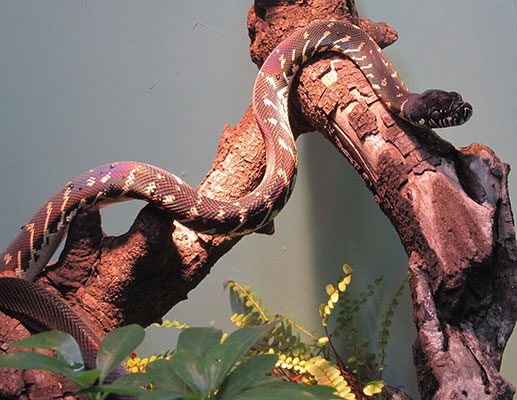
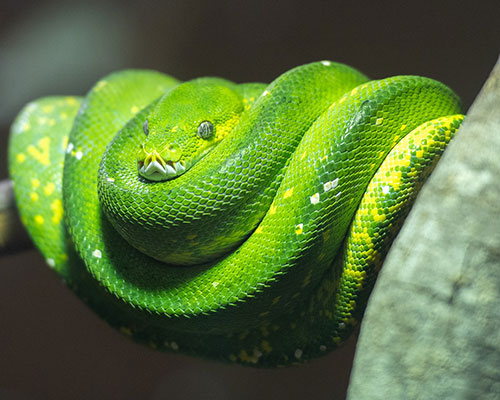

Python Food Preferences
Pythons typically enjoy rodents, rabbits, small birds, eggs, and even other snakes.
Pythons will eat leopards, wallabies, monkeys, and some have even been recorded enjoying antelope and lion.
However, in Asia, people eat python!!
Python food preferences vary among the 30 plus species and is dependent on the specie’s location and their environment.
For example, more aquatic python species will feed on animals that are more likely to live in or near water sources.
Pythons that prefer woodlands and grasslands are more likely to find rabbits and other small rodents as prey. Environmental influences largely affect the food preferences of the numerous python species.
Anacondas
Anacondas Species
Anacondas, a nonvenomous boa constrictor, only have four known species as opposed to the 33 different Python species. Murinus (Green), Notaeus (Yellow or Paraguayan), Deschauenseei (Dark-spotted), and Beniensis (Beni or Bolivian) are the only species of Anacondas.
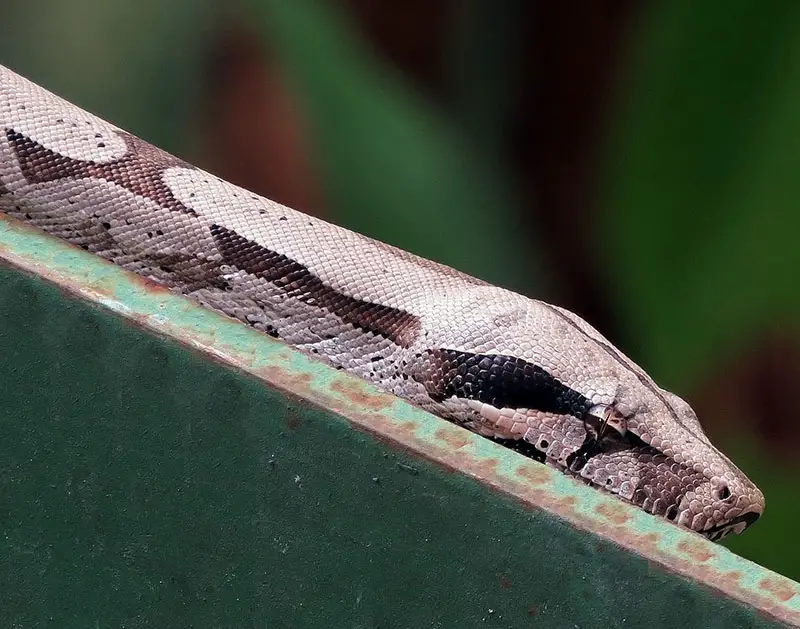
Generally, the Anaconda reaches up to 30 feet (ca. 9 m) in length, dependent on which species, of course!
South America’s Green Anaconda outweighs any other snake in the world, weighing in at 550 pounds (ca. 249 kg) on average. South America’s Green Anaconda outweighs the heaviest python species, the Reticulated Python.
Anaconda Colors
Anaconda’s coloration is usually brownish-green with black spots allowing them to excel as predators in the murky, brackish waters they inhabit. Being the largest snake worldwide, it is paramount that this beast can camouflage itself.
Anacondas Food Preferences
Anacondas are types of boa constrictors and use the same suffocation method to kill its prey as many python species use.
Anacondas spend most their lives near or in water so their food preferences include fish, other snakes and reptiles that also reside in water, but also animals that drink water, like capybaras, large wild cats, and wild pigs.
Anacondas have even been known to eat jaguars and other large cats.
Being such fierce predators, anaconda species can eat larger animals because they themselves are larger and can take down and constrict larger prey.
Counting the element of surprise, anacondas rely on their ability to blend in with their environments.
While their vast size makes it hard for them to become completely invisible, their coloration certainly helps. Watch this video on YouTube as gigantic anaconda devours a huge meal!
Anaconda Habitats
The habitat of Anacondas consists of swampy, river ecosystems in South America.
Usually, east of the Andes Mountains, which is one of the world’s longest mountain ranges that includes land from Venezuela travelling through quite a few other countries, such as Ecuador, Colombia, Bolivia, Peru, Argentina, and Chile!
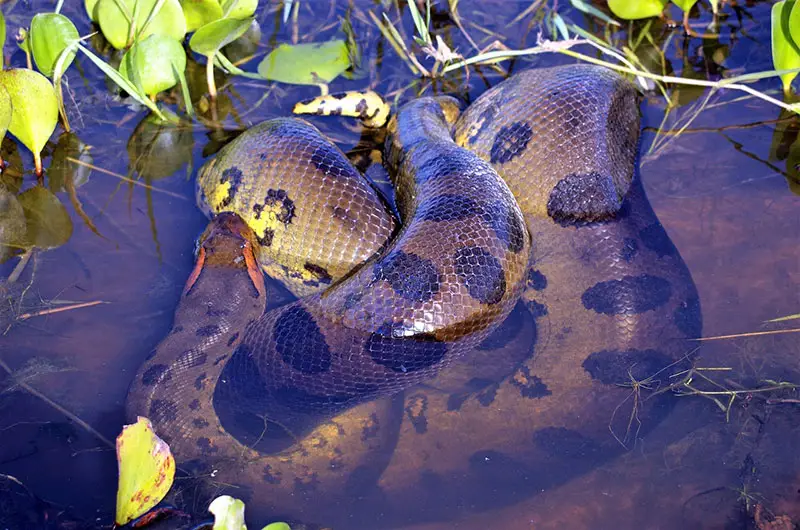
The Andes Mountain terrain consists of volcanoes, deserts, lakes, grasslands, and forests, making it a prime habitat for thousands of animal species.
It has been recorded that approximately 3700 animal species live in the Andes Mountain range.
More specifically, 200 amphibian species, 400 fish species, 600 reptile species, 600 mammal species, and 1700 bird species thrive in this mountain habitat.
Differences between Pythons and Anacondas
While Pythons and Anacondas share some common snake traits, they have their differences.
Species
The numerous python species differ from the four anaconda species.
Pythons are classified in their category, but anacondas are classified with boa constrictors.
Anacondas, a nonvenomous boa constrictor, only have four known species. This differs from the 30 plus different Python species that are slithering around the Earth. Murinus (Green), Notaeus (Yellow or Paraguayan), Deschauenseei (Dark-spotted), and Beniensis (Beni or Bolivian) are the only known snakes of the anacondas.
Habitats
Habitats and environments are similar, but have different locations on different continents. Food preferences differ in different environments and with different species, which is common in the Animal Kingdom.
Anacondas that enjoy aquatic habitats enjoy more aquatic animals for food, while most python species prefer land animals, such as rodents, birds, other snakes, monkeys, and predatory cat species.
Other Attributes
Physical attributes, like python and anaconda colors, are contrasted among the various species.
Anaconda and python females are often larger than the male sexes.
The natural commonalities among snake species is to be expected.
Pythons and anacondas are quite different, but still share similar traits because they belong to the same family, SNAKES!
FAQ
Is anaconda a type of python?
Anacondas and pythons belong to two different families of snakes, so they are not the same. Anacondas belong to the boa constrictor family, while python is from the Pythonidae family.
Are pythons bigger than anacondas?
As a whole, pythons tend to be longer snakes than anaconda, while anacondas are generally heavier and thicker.
Remember that there are various species of Pythons, ranging from the Pygmy Python that is smaller than your hand to big specimens weighting around 250 pounds. So, the answer can vary from one snake to another.
Conclusion
When comparing and contrasting any animal within a homogeneous species group, such as snakes, similar characteristics, behaviors, and other traits are to be expected.
However, as with everything on planet Earth, nothing is the same. Variations and alternatives are endless.
Pythons and anacondas sizes may vary, their habitat locations may skip from continent to continent, but their physical characteristics such as color and behaviors differ in countless ways.
Python and anaconda snake species compare and contrast in a number of different ways and scientific research changes daily as humans learn more about the environment and the plants and animals that make up Earth’s environment.
Want more? There are also a few differences between Pythons and Cobras that you need to know. Click on the link to check the corresponding article.

